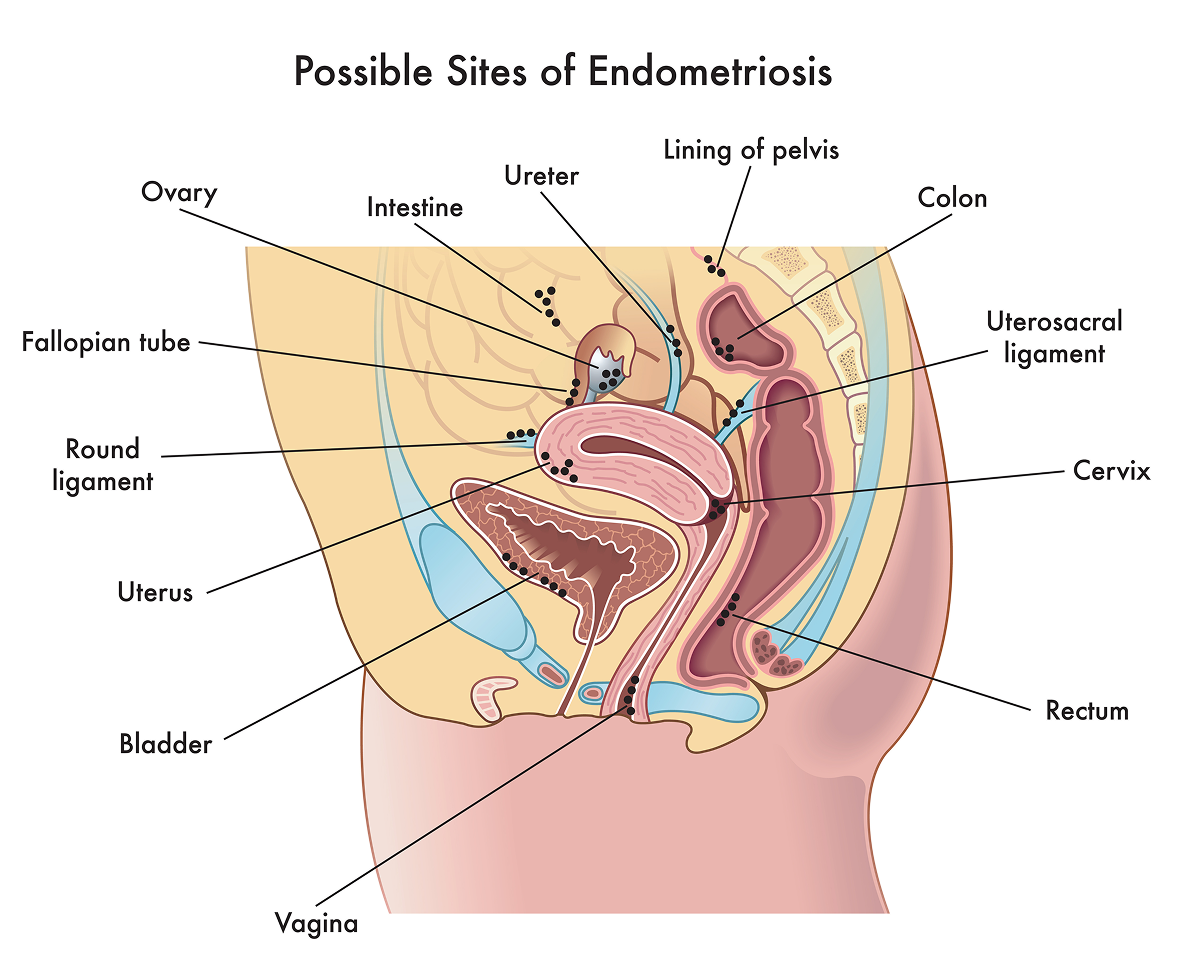Endometriosis
Find a specialistEndometriosis is one of the most common gynecological diseases, but its cause is not known. It can affect the reproductive organs and other body parts. Your Advocate care provider will work with you to find treatment for the symptoms that affect you.
What kind of pain does endometriosis cause?
Endometriosis pain can be severe enough to be debilitating. It’s usually centered in the pelvis and lower abdomen. Endometriosis pain may be constant, or it may consist of cramps and pain during menstrual periods. Pain may occur during urination, bowel movements or during or after sexual intercourse.
What is endometriosis?

Endometriosis growths may occur in many parts of the abdomen and pelvis.
Endometriosis consists of growths that resemble the lining of the uterus but form outside the uterus. These growths – also called lesions, implants or nodules – can be found on the ovaries, fallopian tubes or uterus. They may also form on the bladder, intestines or walls of the pelvis or abdomen.
Endometriosis tissues react like the lining of the uterus during menstrual periods. The tissues swell, and they release blood and chemicals. But the blood stays inside your body, where it causes irritation wherever it lands. This irritation may also cause organs to stick together and form scar tissue.
What are the stages of endometriosis?
Your doctor will tell you the stage of your endometriosis stage, based on a set of guidelines that include the number of implants, the presence of adhesions and whether the implants affect other pelvic organs.
The stages of endometriosis are:
- I - Minimal
- II - Mild
- III - Moderate
- IV – Severe
It’s important to note that you may have heavy pain from endometriosis even if your doctor says you’re at the mild stage. And you may have mild pain even if your stage is severe.
Endometriosis symptoms
The main symptom of endometriosis is abdominal and pelvic pain. Other endometriosis symptoms include:
- Heavy menstrual periods
- Premenstrual spotting or bleeding between periods
- Gastrointestinal symptoms similar to a bowel disorder
- Fatigue and lack of energy
- Trouble getting pregnant
Endometriosis diagnosis
Endometriosis is diagnosed based on potential endometriosis symptoms, an exam and minimally invasive surgery to identify endometriosis growths. Different types of imaging, such as ultrasound or MRI may be used to help find areas of endometriosis on your reproductive organs or other parts of your abdomen.
To identify endometriosis tissues, your doctor may perform a minimally invasive procedure called a laparoscopy. They’ll insert a narrow tube through a small incision to view areas of endometriosis inside your body. Your doctor may also remove lesions during a laparoscopy to use for a biopsy or as endometriosis treatment.
Endometriosis treatments
Endometriosis is usually treated with medications, surgery or a combination of the two treatments. Your provider’s first recommendation may be to try NSAIDs – nonsteroidal anti-inflammatory drugs that are readily available. They help treat the pain, but don’t stop endometriosis from developing.
Other types of medications that may be used for endometriosis treatment are:
- Birth control pills: These alter the menstrual cycle and prevent hormone levels from changing as much.
- Progestins: Forms of progesterone that keep estrogen levels low.
- GnRH agonists: Stop the production of estrogen and bring on chemical menopause. They help control pain and may be used with other medications to help control menopausal symptoms.
The type of medication used will depend on whether you plan on becoming pregnant in the future because some treatments prevent pregnancy.
Pregnancy sometimes improves endometriosis symptoms, but it doesn’t work that way for every woman. Menopause may also improve symptoms. But symptoms may come back after some time has passed.
Surgical endometriosis treatments
Your provider may recommend surgery to treat your endometriosis. One form of surgery involves removing as much endometriosis tissue as possible. This is usually done using minimally invasive laparoscopy. However, open surgery may be needed to remove larger areas of endometriosis, scar tissue caused by adhesions or when larger organs such as the intestines are affected.
In the past, hysterectomy was used as a treatment for endometriosis. Hysterectomy is currently used as a last resort when other treatments haven’t worked.
Even after surgery to remove growths or a hysterectomy, endometriosis may still return.
Get care
We help you live well. And we’re here for you in person and online.